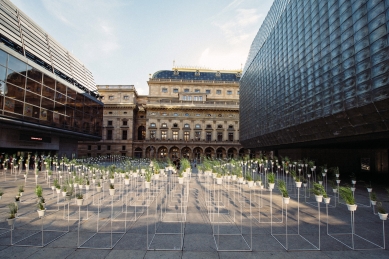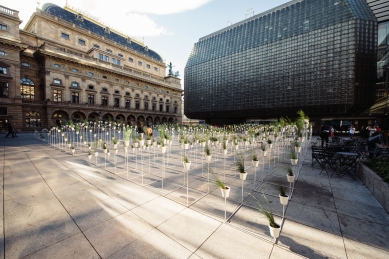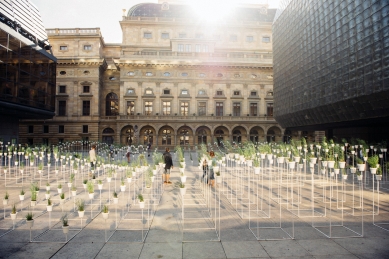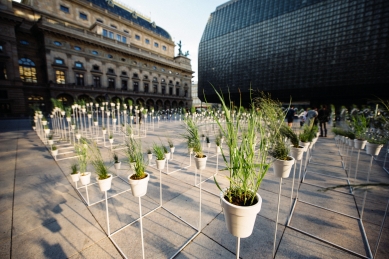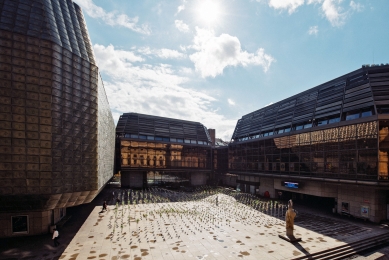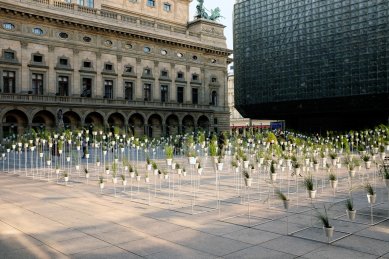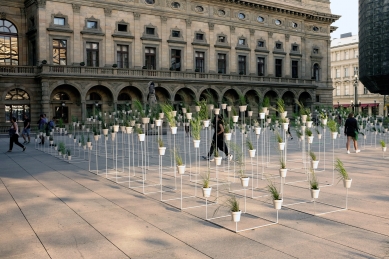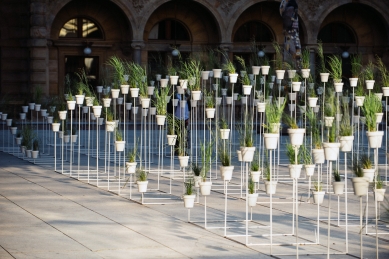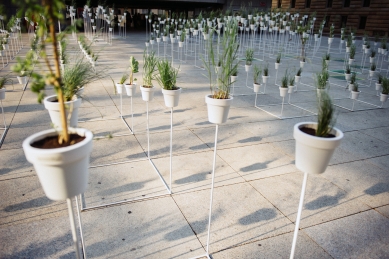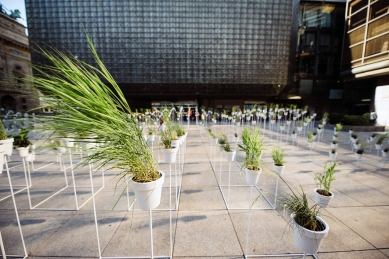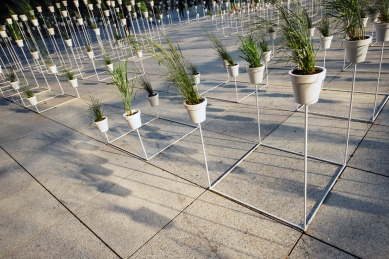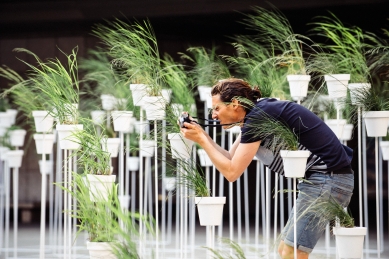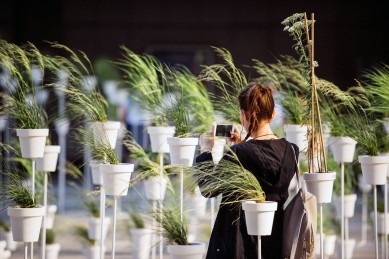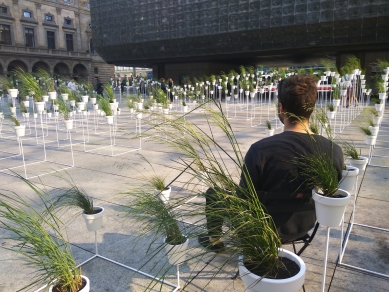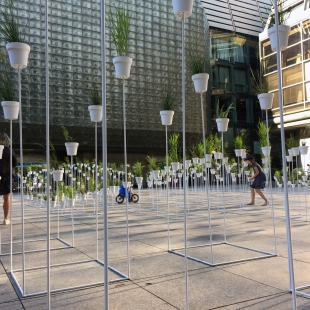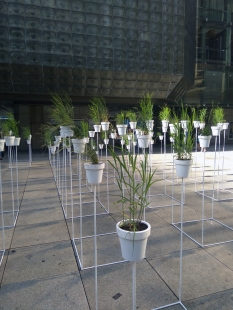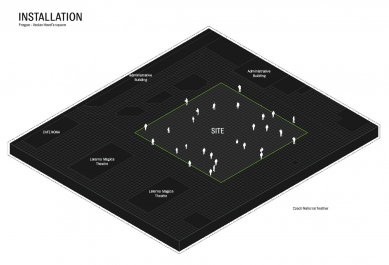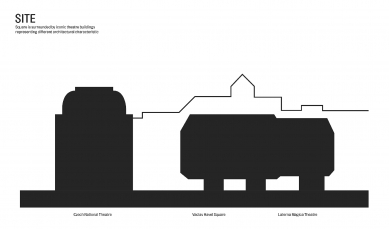
Victoria Pragensis - botanical labyrinth

The claims on the city are changing. City residents want to live the city. They want multifaceted cities that provide diverse spaces. They perceive the city as their own space. A space that is part of their homes, apartments. A space where they spend more time. A space that is gaining increasing interest.
The importance of greenery, urban parks, or community gardens creating urban microclimates is growing. Greenery is perceived as an indicator of the quality of the city and often has a significant impact on the choice of location within the city. Awareness of the importance of plants for humans and for the city is increasing.
The installation Victoria Pragensis is a temporary landscape in urban space. It is a landscape made up of nearly a thousand plants creating soft green contours that contrast with the surrounding buildings of the National Theatre. The installation fundamentally changes the space of the square. It creates a "forest of plants" surrounding each visitor. This green mass is a kind of labyrinth that arises from the grid of the square and leads the visitor to its center, where they are completely enveloped by the plants.
The installation predominantly features one type of ornamental grass that creates a scenography for medicinal plants used in medicine for their specific effects. These should be discovered and familiarized with within the installation.
All the plants are randomly distributed throughout the installation at various heights according to the height of the structure, which we understand as an analogy to the trunks of the forest bearing branches with leaves. The entire levitating topography descends towards the center of the installation, where the plants are laid the lowest to create an imaginary meadow.
The authors encourage the use of public spaces with the installation, which they perceive as part of our living rooms, workspaces, and places to relax.
The main idea of the Hænke project is to contribute to the achievement of general welfare by raising awareness of the role of medicinal plants in society. It presents the scientific fields of ethnobotany, phytotherapy, and pharmacognosy to the broader public, particularly through organizing lectures and workshops on natural science topics, presenting these disciplines in the context of urban life and creative industries (art and culture in general), and implementing projects that connect the scientific and artistic communities.
With the increasing interest in sustainable development, many people are returning to the traditions of natural medicine as a gentle and natural alternative to synthetic drugs. However, the information available is not always scientifically verified, and natural remedies are often misapplied. In our Žižkov space Hænke Botanical Lab, we strive to bring people closer to the role of medicinal plants in connection with Czech design and art: our "laboratory" also serves as a showroom for young Czech designers whose ethical creed resonates with us.
Julien Antih is a French pharmacist and ethnobotanist specializing in the application of medicinal plants in pharmaceuticals. He is the author of several research studies in collaboration with University College London or Universidad de Barcelona. Together with him, HAENKE comprises a team of experts from the fields of science, architecture, and other creative sectors.
The name of the project is inspired by the work of the famous Czech botanist, researcher, and explorer Tadeáš Haenke, who participated in several significant transoceanic expeditions at the turn of the 18th and 19th centuries during which he described a large number of new medicinal plants primarily from Latin America. His extensive collections are located, among other places, in the Prague Natural History Museum.
The importance of greenery, urban parks, or community gardens creating urban microclimates is growing. Greenery is perceived as an indicator of the quality of the city and often has a significant impact on the choice of location within the city. Awareness of the importance of plants for humans and for the city is increasing.
The installation Victoria Pragensis is a temporary landscape in urban space. It is a landscape made up of nearly a thousand plants creating soft green contours that contrast with the surrounding buildings of the National Theatre. The installation fundamentally changes the space of the square. It creates a "forest of plants" surrounding each visitor. This green mass is a kind of labyrinth that arises from the grid of the square and leads the visitor to its center, where they are completely enveloped by the plants.
The installation predominantly features one type of ornamental grass that creates a scenography for medicinal plants used in medicine for their specific effects. These should be discovered and familiarized with within the installation.
All the plants are randomly distributed throughout the installation at various heights according to the height of the structure, which we understand as an analogy to the trunks of the forest bearing branches with leaves. The entire levitating topography descends towards the center of the installation, where the plants are laid the lowest to create an imaginary meadow.
The authors encourage the use of public spaces with the installation, which they perceive as part of our living rooms, workspaces, and places to relax.
The main idea of the Hænke project is to contribute to the achievement of general welfare by raising awareness of the role of medicinal plants in society. It presents the scientific fields of ethnobotany, phytotherapy, and pharmacognosy to the broader public, particularly through organizing lectures and workshops on natural science topics, presenting these disciplines in the context of urban life and creative industries (art and culture in general), and implementing projects that connect the scientific and artistic communities.
With the increasing interest in sustainable development, many people are returning to the traditions of natural medicine as a gentle and natural alternative to synthetic drugs. However, the information available is not always scientifically verified, and natural remedies are often misapplied. In our Žižkov space Hænke Botanical Lab, we strive to bring people closer to the role of medicinal plants in connection with Czech design and art: our "laboratory" also serves as a showroom for young Czech designers whose ethical creed resonates with us.
Julien Antih is a French pharmacist and ethnobotanist specializing in the application of medicinal plants in pharmaceuticals. He is the author of several research studies in collaboration with University College London or Universidad de Barcelona. Together with him, HAENKE comprises a team of experts from the fields of science, architecture, and other creative sectors.
The name of the project is inspired by the work of the famous Czech botanist, researcher, and explorer Tadeáš Haenke, who participated in several significant transoceanic expeditions at the turn of the 18th and 19th centuries during which he described a large number of new medicinal plants primarily from Latin America. His extensive collections are located, among other places, in the Prague Natural History Museum.
The English translation is powered by AI tool. Switch to Czech to view the original text source.
1 comment
add comment
Subject
Author
Date
...
03.05.18 12:30
show all comments


